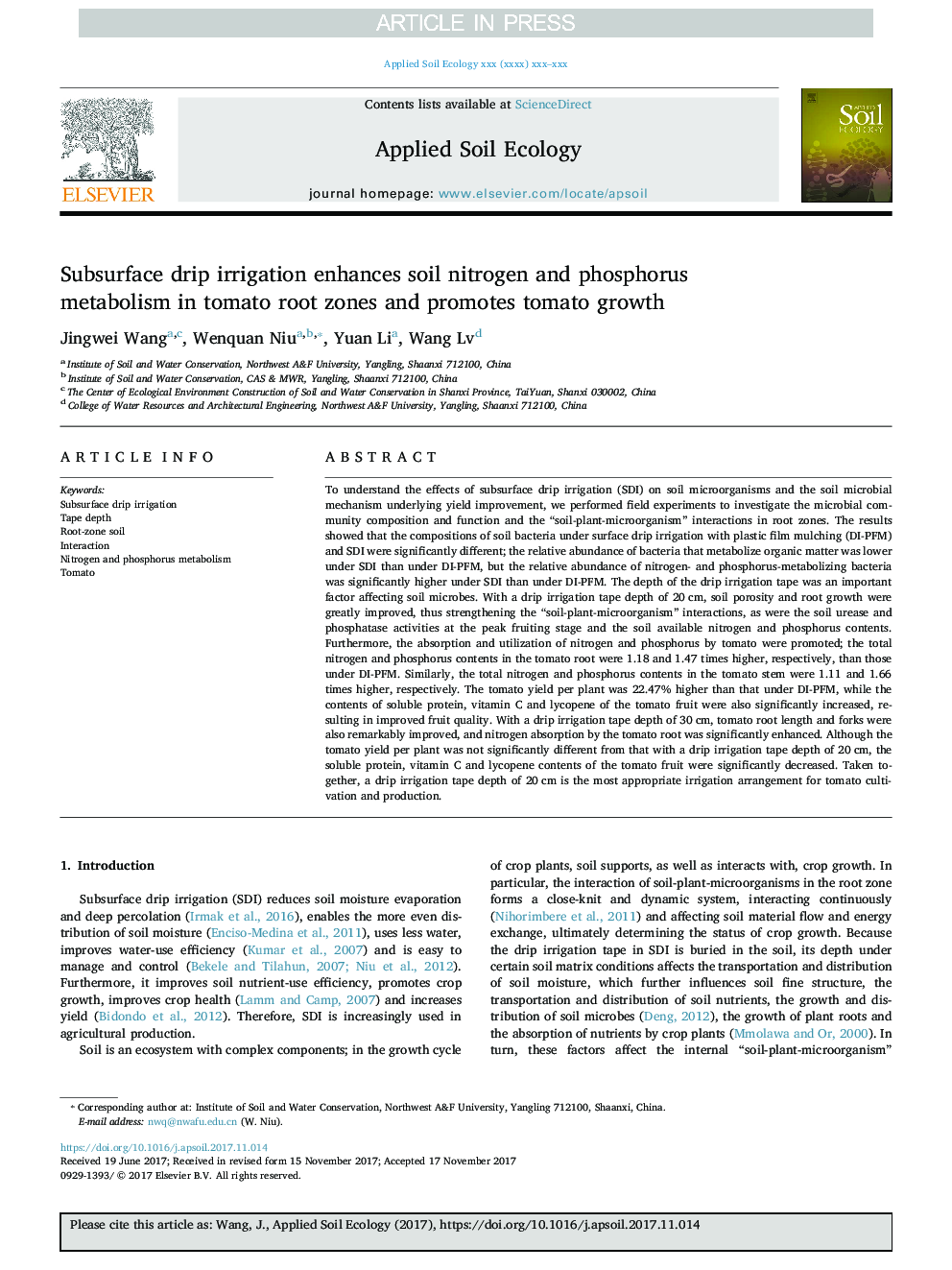| کد مقاله | کد نشریه | سال انتشار | مقاله انگلیسی | نسخه تمام متن |
|---|---|---|---|---|
| 8846793 | 1617759 | 2018 | 12 صفحه PDF | دانلود رایگان |
عنوان انگلیسی مقاله ISI
Subsurface drip irrigation enhances soil nitrogen and phosphorus metabolism in tomato root zones and promotes tomato growth
ترجمه فارسی عنوان
آبیاری قطره ای زیرزمینی نیتروژن خاک و متابولیسم فسفر را در مناطق ریشه گوجه فرنگی افزایش می دهد و رشد گوجه فرنگی را افزایش می دهد
دانلود مقاله + سفارش ترجمه
دانلود مقاله ISI انگلیسی
رایگان برای ایرانیان
کلمات کلیدی
آبیاری قطره زیرسطحی عمق نوار، خاک ریشه، اثر متقابل، متابولیسم نیتروژن و فسفر، گوجه فرنگی،
موضوعات مرتبط
علوم زیستی و بیوفناوری
علوم کشاورزی و بیولوژیک
بوم شناسی، تکامل، رفتار و سامانه شناسی
چکیده انگلیسی
To understand the effects of subsurface drip irrigation (SDI) on soil microorganisms and the soil microbial mechanism underlying yield improvement, we performed field experiments to investigate the microbial community composition and function and the “soil-plant-microorganism” interactions in root zones. The results showed that the compositions of soil bacteria under surface drip irrigation with plastic film mulching (DI-PFM) and SDI were significantly different; the relative abundance of bacteria that metabolize organic matter was lower under SDI than under DI-PFM, but the relative abundance of nitrogen- and phosphorus-metabolizing bacteria was significantly higher under SDI than under DI-PFM. The depth of the drip irrigation tape was an important factor affecting soil microbes. With a drip irrigation tape depth of 20Â cm, soil porosity and root growth were greatly improved, thus strengthening the “soil-plant-microorganism” interactions, as were the soil urease and phosphatase activities at the peak fruiting stage and the soil available nitrogen and phosphorus contents. Furthermore, the absorption and utilization of nitrogen and phosphorus by tomato were promoted; the total nitrogen and phosphorus contents in the tomato root were 1.18 and 1.47 times higher, respectively, than those under DI-PFM. Similarly, the total nitrogen and phosphorus contents in the tomato stem were 1.11 and 1.66 times higher, respectively. The tomato yield per plant was 22.47% higher than that under DI-PFM, while the contents of soluble protein, vitamin C and lycopene of the tomato fruit were also significantly increased, resulting in improved fruit quality. With a drip irrigation tape depth of 30Â cm, tomato root length and forks were also remarkably improved, and nitrogen absorption by the tomato root was significantly enhanced. Although the tomato yield per plant was not significantly different from that with a drip irrigation tape depth of 20Â cm, the soluble protein, vitamin C and lycopene contents of the tomato fruit were significantly decreased. Taken together, a drip irrigation tape depth of 20Â cm is the most appropriate irrigation arrangement for tomato cultivation and production.
ناشر
Database: Elsevier - ScienceDirect (ساینس دایرکت)
Journal: Applied Soil Ecology - Volume 124, March 2018, Pages 240-251
Journal: Applied Soil Ecology - Volume 124, March 2018, Pages 240-251
نویسندگان
Jingwei Wang, Wenquan Niu, Yuan Li, Wang Lv,
